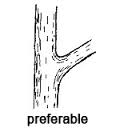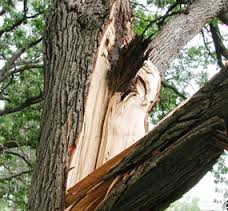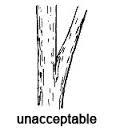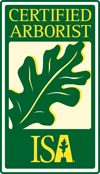| Tree Problems and Disease |
Included Bark“Included bark forms when two branches grow at sharply acute angles to one another, producing a wedge of inward-rolled bark between them (see images). Included bark prevents strong attachment of branches, often causing a crack  at at the point below where the branches meet. Codominant stems that are approximately the same size and arise from the same position often form included bark.Removing some of the lateral branches from a codominant stem can reduce its growth enough to allow the other stem to become dominant” (source: US Forest Service).Proper tree pruning, especially early on, is important bacause one of the most common locations for a tree to fail is at the junction of two or more codominant stems because these branches, in essence, must split the strength of a single branch.Structural tree problems from included bark can occur naturally, but also can result from prior improper trimming and pruning techniques. For example, pollarding or “topping” a tree. the point below where the branches meet. Codominant stems that are approximately the same size and arise from the same position often form included bark.Removing some of the lateral branches from a codominant stem can reduce its growth enough to allow the other stem to become dominant” (source: US Forest Service).Proper tree pruning, especially early on, is important bacause one of the most common locations for a tree to fail is at the junction of two or more codominant stems because these branches, in essence, must split the strength of a single branch.Structural tree problems from included bark can occur naturally, but also can result from prior improper trimming and pruning techniques. For example, pollarding or “topping” a tree.
Common Western Tree Diseases (source: US Forest Service)
|

 ISA Certified Arborist (#PN-0234A)
ISA Certified Arborist (#PN-0234A)